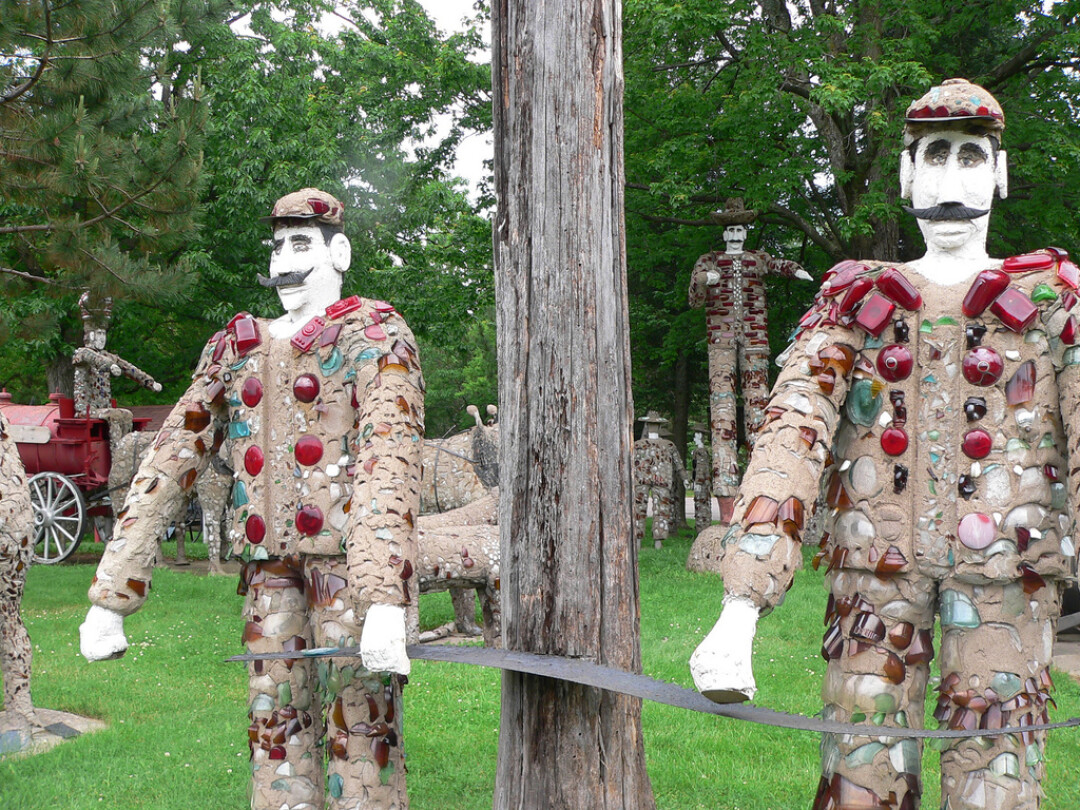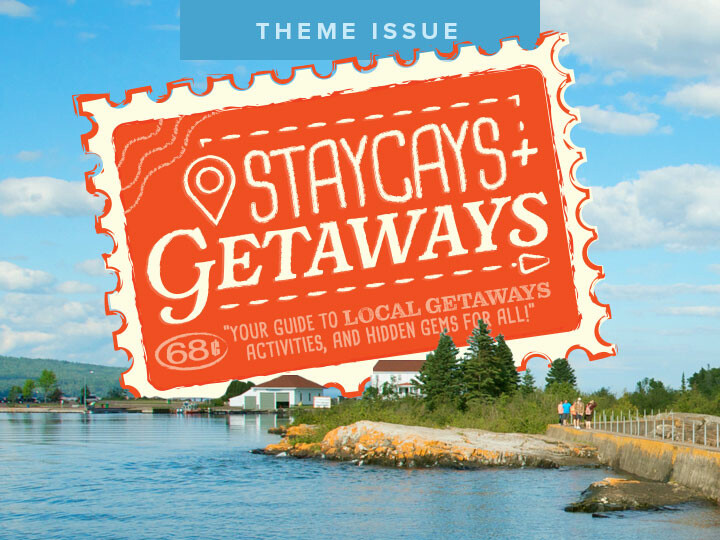Drive to Create: Take a tour of self-taught art on Wisconsin’s backroads

Folk art. Self-taught art. Outsider art. Pop art. Whatever you choose to call it, Wisconsin has long been famous for the unique creations of self-taught artists. Throughout the state, the final creative products of their expression, vision, and inspiration have remained on Wisconsin back roads for the rest of us to appreciate and enjoy. Most of these exhibits are outdoors, providing visitors ample opportunity to experience the state’s abundance of natural resources and recreation. The artists featured in this tour did not have any artistic training, but what these informal artists lacked in education was more than made up for by their inspiration, creativity, passion, and drive to create.
Take a road trip and explore the state’s collection of eclectic – and sometimes eccentric – sculpture gardens that are the unique visions of untrained artists. To lovers of outsider art they are places of wonder.
Day 1: Northern & Central Wisconsin
Wisconsin Concrete Park
The Self-taught Artist Tour begins in Phillips at one of Wisconsin’s most famous outdoor folk-art museums, Wisconsin Concrete Park. Created by artist Fred Smith, this open-air exhibit features concrete structures festooned with bits of glass, ceramics, and stones. A former lumberjack, farmer and tavern owner, Smith documented the Northwoods way of life in more than 200 figures of mythical and real characters. At age 65, Smith began filling his front yard with statues of Paul Bunyan, Kit Carson, Abe Lincoln, Sacajawea, the Statue of Liberty, and Ben Hur, among many others. Located on Highway 13, south of Phillips, the park is open year-round from dawn until dusk.
Jurustic Park
A two-hour drive south on Highway 13 leads art seekers to Marshfield’s Jurustic Park, where artist Claude Wynia works with both iron and irony. Here, visitors can enjoy a whimsical array of junkyard creatures – dragons, frogs, turtles, and more – all displayed outdoors. View more than 250 examples of swampland life from small 6-inch spiders and mosquitoes to 45-foot, 4,000-pound flying dragons. Adjacent to the metal sculpture garden, Wynia’s wife, Nancy, has her own studio/shop, the Hobbit House, exhibiting her handmade glass beads, flowers, sculpture and life-size soft sculpture dolls.
Wonder Cave
Just minutes away on Highway 34 in Rudolph, the floral walkways and gardens, folk-art memorials and shrines of the Rudolph Grotto Gardens and Wonder Cave await visitors. Created by Father Philip J. Wagner and Edmund Rybicki as shrine to the Blessed Mother, the Wonder Cave was built with a maze of walkways and a series of biblically inspired scenes made of sheets of tin with proverbs spelled out in pinholes and backlit by colored lights. The grotto is located on the parish grounds of St. Philip the Apostle Church.
Day 2: Western Wisconsin
Paul and Matilda Wegner Grotto
Locally known as the “Glass Church,” the Paul and Matilda Wegner Grotto is located in Cataract just south of the Black River State Forest on Highway 27. This rustic sculpture garden is a beautiful example of grassroots art. The most striking work is a glass and concrete re-creation of this German immigrant couples’ 50th wedding anniversary cake. Upon Paul’s retirement in 1927, inspired by the work of Father Mathius Wernerus, who created the Dickeyville Grotto, the couple returned to their Cataract farm and began turning the grounds into a sculpted environment of concrete, glass shards, china, and porcelain pieces. In 1986, the Kohler Foundation purchased the site as part of its commitment to document and preserve significant outsider art environments and folk architecture. Today, visitors can view the shared passion of Paul and Matilda.
Prairie Moon Sculpture
The next stop takes art enthusiasts to the Mississippi River community of Cochrane. In 1959, at the age of 74, Herman Rusch was inspired to build the first concrete and stone planter that later grew into what is now known as the Prairie Moon Sculpture. His effort led to an interest in creating huge sculptures and related flower beds. By the time Rusch had entered his 90s, he had created nearly 40 concrete, stone, and rock sculptures. Dinosaurs, decorative fences, and arches all share the grounds with a huge snake, castle tower, Hindu temple, rocket, and the artist’s self-portrait. Using inventive fabrication techniques and materials, including bricks, iron wheels, old grain drills, crockery, glass, and seashells, Rusch created a colorful folk art tour de force. Another preservation project of the Kohler Foundation, tour guides are available.
Day 3: Southern Wisconsin
Dickeyville Grotto
Among Wisconsin’s best-known outdoor art venues is the Dickeyville Grotto in Dickeyville. Built between 1925 and 1931 by parish priest Father Mathias Wernerus, the grotto is actually a cluster of caves and small shrines elaborately embellished with natural curiosities from throughout the world: coral, shells, starfish, petrified sea urchins, petrified wood, coal, quartz, iron ore, onyx, stone, glass, and Indian relics. Constructed using 6,000 bags of cement, it features both religious and patriotic themes. The Grotto is open year-round.
Grandview Sculpture Garden
About an hour’s drive east of Dickeyville is Hollandale, home to the Grandview Sculpture Garden. Here, Austro-Hungarian immigrant Nick Engelbert converted his wooden house into a decorated concrete palace, surrounding it with concrete sculptures reflecting his heritage and sense of humor. He named his garden after the “grand view” of the surrounding farmland. After suffering a sprained ankle in the mid 1930s, Engelbert created his first statue. By the 1950s the entire yard was transformed into an artistic landscape of more than 40 concrete sculptures, many arranged in elaborate settings with lush colorful garden beds. Today the site functions as a community arts center and the grounds are open year-round during daylight hours.
Dr. Evermor’s Forevertron
The last art stop of the day is Prairie du Sac, where the fantastical machines of the famous Dr. Evermor’s Forevertron will delight art seekers. The centerpiece of this sculpture garden is a massive celestial traveling device that is also the world’s largest scrap metal sculpture. Taking salvaged factory parts and using Prairie Style elements evocative of Frank Lloyd Wright, Dr. Evermor fashioned sculptures that evoke both the natural world and sci-fi. Dozens of mechanical creatures, ranging from waist-high to 20 feet tall, flock in clearings. Disintegration chambers, spaceship gun turrets, and huge contraptions suggest prehistoric or space-age insects. There are no labels or explanations, so you’ll need to talk to Dr. Evermor himself.
Day 4: Eastern Wisconsin
James Tellen Woodland Sculpture Garden
The last day of the Self-taught Artist Tour takes art spectators to the shores of Lake Michigan. A shady, wooded lot in Kohler, just a stone’s throw from the shoreline, is the home to the James Tellen Woodland Sculpture Garden. Here stands a rustic cabin surrounded by 30 realistic, and often whimsical, concrete statues. Former furniture factory worker James Tellen turned his family’s summer cottage into a dramatic sculpture garden filled with figures depicting prairie settlers, Native Americans, and woodland creatures. Although not formally trained as an artist, Tellen adhered to classical notions of art following nature, and strove to make his work as realistic as possible. Tours are available by appointment through the John Michael Kohler Arts Center.
Rudy Rotter Museum of Sculpture
End your adventure with a short drive north to Manitowoc, home of the Rudy Rotter Museum of Sculpture. Fourteen-thousand pieces of rare wood, stone and bone carvings, ceramics and plaster, metal casting, mixed media constructions, and other pierces sculpted by self-taught artist Rudy Rotter are on display. Rotter has been called the most prolific artist in Wisconsin history, creating an estimated 16,000 works of art over a 45-year period. His artistic output is considered remarkable in that he had no formal art training, just industrious hard work over many decades. Contact the museum for an appointment. Learn more at rudyrotterart.com.

